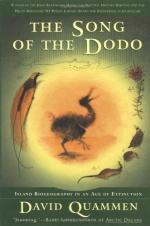
|
| Name: _________________________ | Period: ___________________ |
This test consists of 5 multiple choice questions, 5 short answer questions, and 10 short essay questions.
Multiple Choice Questions
1. What did William Newmark determine in his findings?
(a) That species count and reserve area correlated.
(b) That species proliferate differently in different kinds of ecosystems.
(c) That species count and reserve area are not always correlated.
(d) That the number of species is less valuable than the number of predators in indicating the health of an ecosystem.
2. What does Quammen say about Wilson and Macarthur's 'The Theory of Island Biogeography'?
(a) It was a book that changed things.
(b) It was doubted at the time it was published.
(c) Its effect was not felt for years.
(d) It was practically unnoticed.
3. How many individuals were thought to be necessary to prevent harmful inbreeding?
(a) 50.
(b) 200.
(c) 500.
(d) 5,000.
4. What does Quammen believe happened to Bedo?
(a) He made people jealous with the money he was making as a guide.
(b) He made people angry by raising consciousness as he talked with people from many different walks of life.
(c) He made people uncomfortable being around white people a lot of the time.
(d) He made enemies among the hunters.
5. Which theory is Quammen supporting when he cites the work of William Newmark?
(a) The keep reserves close together model.
(b) The single large reserve model.
(c) The many small reserves model.
(d) The keep reserves apart model.
Short Answer Questions
1. What was the consequence of the Simberloff and Abele article?
2. What strategy was Karen Strier opposed to using, for preserving the muriqui population?
3. How does Quammen describe Aru?
4. What does Quammen say is distinctive about the indri?
5. Where do the indri live?
Short Essay Questions
1. What did MacArthur and Wilson argue in 'An Equilibrium Theory of Insular Zoogeography'?
2. How do genetics play a role in the minimum viable population?
3. Where was Quammen sent, in order to find what he was looking for?
4. What data did Simberloff and Abele deploy in challenging this theory?
5. How did Quammen get to Aru?
6. What does Quammen say about applying the case of the Mauritius kestrel to other species?
7. What is the definition of 'viable' in Quammen's account?
8. What factors affected the populations on an island, according to 'An Equilibrium Theory of Insular Zoogeography'?
9. How did Carl Jones save the Mauritius kestrel?
10. Why did Quammen choose Aru as the destination for his final chapter?
|
This section contains 776 words (approx. 3 pages at 300 words per page) |

|




